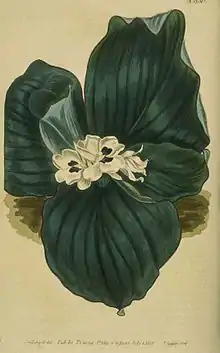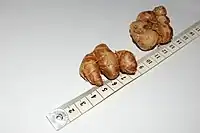| Kaempferia galanga | |
|---|---|
 | |
| Drawing from an 1805 issue of The Botanical Magazine | |
| Scientific classification | |
| Kingdom: | Plantae |
| Clade: | Tracheophytes |
| Clade: | Angiosperms |
| Clade: | Monocots |
| Clade: | Commelinids |
| Order: | Zingiberales |
| Family: | Zingiberaceae |
| Genus: | Kaempferia |
| Species: | K. galanga |
| Binomial name | |
| Kaempferia galanga | |
Kaempferia galanga, commonly known as kencur, aromatic ginger, sand ginger, cutcherry, is a monocotyledonous plant in the ginger family, and one of four plants called galangal. It is found primarily in open areas in Indonesia, southern China, Taiwan, Cambodia, and India, but is also widely cultivated throughout Southeast Asia.
Culinary and medical use
Kaempferia galanga is used as a spice in cooking in Indonesia, where it is called kencur ('cekur' in Malaysia), and especially in Javanese and Balinese cuisines. Beras kencur, which combines dried K. galanga powder with rice flour, is a particularly popular jamu herbal drink. Its leaves are also used in the Malay rice dish, nasi ulam.
Unlike the similar Boesenbergia rotunda (Thai กระชาย krachai), K. galanga is not commonly used in Thai cuisine, but can be bought as a dried rhizome or in powder form at herbal medicine stalls. It is known in Thai as proh horm (เปราะหอม) or waan horm (ว่านหอม), and in Khmer as prâh (ប្រោះ) or prâh krâ-oup (ប្រោះក្រអូប). It is also used in Chinese cooking and Chinese medicine, and is sold in Chinese groceries under the name sha jiang (Chinese: 沙 姜; pinyin: shajiang),[1] while the plant itself is referred to as shan nai (Chinese: 山 柰; pinyin: shannai).[2] Kaempferia galanga has a peppery camphorous taste.[1]
Similar species
K. galanga is differentiated from other galangals by the absence of stem and dark brown, rounded rhizomes, while the other varieties all have stems and pale rosebrown rhizomes. It is also sometimes called lesser galangal, which properly refers to Alpinia officinarum.
Chemical constituents
The rhizomes of aromatic ginger have been reported to contain cineol, borneol, 3-carene, camphene, kaempferol, kaempferide, cinnamaldehyde, p-methoxycinnamic acid, ethyl cinnamate, and ethyl p-methoxycinnamate.
Insecticidal research
Extracts of the plant kill larvae of several species of mosquito including some that are disease vectors.[10][11] As a result of these findings, research is underway to evaluate the plant extract's use as an insect repellent, with preliminary findings suggesting it is not an irritant to the skin of rats.[12]
Extracts and essential oils

The rhizomes of the plant, which contain essential oils, have been used in traditional Chinese medicine as a decoction or powder. Its alcoholic maceration has also been applied as liniment for rheumatism.[12] The extract causes central nervous system depression, a decrease in motor activity, and a decrease in respiratory rate.[13]
The decoctions and the sap of the leaves may have hallucinogenic properties, which may be due to unidentified chemical components of the plant’s essential oil fraction.[14]
A purified extract of K. galanga and polyester-8 stabilize the UV-absorptive properties of sunscreen combinations containing avobenzone.[15]
Aroma attributes
- Borneol[16]
- 1,8-Cineole[16]
- Ethyl cinnamate[16], [17]
- Ethyl p-methoxycinnamate[16][18]
- Gamma-car-3-ene[16]
- Pentadecane[16]
See also
References
- 1 2 Van Wyk, Ben-Erik (2005). Food Plants of the World. Portland, Oregon: Timber Press, Inc. ISBN 978-0-88192-743-6.
- ↑
Wu, Delin; Larsen, Kai (2000). "Kaempferia galanga". In Wu, Z. Y.; Raven, P.H.; Hong, D.Y. (ed.). Flora of China. Vol. 22. Beijing: Science Press; St. Louis: Missouri Botanical Garden Press. p. 74. Retrieved 16 July 2007.
{{cite book}}: CS1 maint: multiple names: authors list (link) - 1 2 3 4 Chan, E.W.C.; et al. (2008). "Antioxidant and tyrosinase inhibition properties of leaves and rhizomes of ginger species". Food Chemistry. 109 (3): 477–483. doi:10.1016/j.foodchem.2008.02.016.
- 1 2 3 Chan, E.W.C.; et al. (2009). "Effects of different drying methods on the antioxidant properties of leaves and tea of ginger species". Food Chemistry. 113 (1): 166–172. doi:10.1016/j.foodchem.2008.07.090.
- ↑ Chan, E.W.C.; et al. (2009). "Caffeoylquinic acids from leaves of Etlingera species (Zingiberaceae)". LWT - Food Science and Technology. 42 (5): 1026–1030. doi:10.1016/j.lwt.2009.01.003.
- 1 2 Woerdenbag, Herman J.; et al. (2004). "Composition of the essential oils of Kaempferia rotunda L. and Kaempferia angustifolia Roscoe rhizomes from Indonesia". Flavour and Fragrance Journal. 19 (2): 145–148. doi:10.1002/ffj.1284.
- 1 2 Nugroho, Bambang W.; et al. (1996). "Insecticidal constituents from rhizomes of Zingiber cassumunar and Kaempferia rotunda". Phytochemistry. 41 (1): 129–132. doi:10.1016/0031-9422(95)00454-8.
- ↑ Chung SY, et al. (2009). "Potent modulation of P-glycoprotein activity by naturally occurring phenylbutenoids from Zingiber cassumunar". Phytotherapy Research. 23 (4): 472–476. doi:10.1002/ptr.2650. PMID 19051210. S2CID 206424932.
- ↑ Jiang, H.; et al. (2006). "Metabolic profiling and phylogenetic analysis of medicinal Zingiber species: Tools for authentication of ginger (Zingiber officinale Rosc.)". Phytochemistry. 67 (15): 1673–1685. doi:10.1016/j.phytochem.2005.08.001. PMID 16169024.
- ↑ Ahn, Young-Joon; et al. (2008). "Larvicidal activity of Kaempferia galanga rhizome phenylpropanoids towards three mosquito species". Pest Management Science. 64 (8): 857–862. doi:10.1002/ps.1557. PMID 18324612.
- ↑ Kim N.-J., Byun S.-G., Cho J.-E., Chung K., Ahn Y.-J. "Larvicidal activity of Kaempferia galanga rhizome phenylpropanoids towards three mosquito species." Pest Management Science 2008 64:8 (857-862)
- 1 2 Kanjanapothi, D.; et al. (2004). "Toxicity of crude rhizome extract of Kaempferia galanga L. (Proh Hom)". Journal of Ethnopharmacology. 90 (2–3): 359–365. doi:10.1016/j.jep.2003.10.020. PMID 15013202.
- ↑ Kanjanapothi, D; Panthong, A; Lertprasertsuke, N; Taesotikul, T; Rujjanawate, C; Kaewpinit, D; Sudthayakorn, R; Choochote, W; et al. (2004). "Toxicity of crude rhizome extract of Kaempferia galanga L. (Proh Hom)". Journal of Ethnopharmacology. 90 (2–3): 359–65. doi:10.1016/j.jep.2003.10.020. PMID 15013202.
- ↑ Thomas Nordegren (2002). The A-Z Encyclopedia of Alcohol and Drug Abuse. Universal-Publishers. p. 303. ISBN 978-1-58112-404-0.
- ↑ Gonzalez A., Gaenzler F. "Photostability of sunscreen combinations containing avobenzone exposed to natural and artificial ultraviolet light." Journal of the American Academy of Dermatology 2011 64:2 SUPPL. 1 (AB30)
- 1 2 3 4 5 6 Wong, K. C.; et al. (2006). "Composition of the essential oil of rhizomes of kaempferia galanga L". Flavour and Fragrance Journal. 7 (5): 263–266. doi:10.1002/ffj.2730070506.
- ↑ Othman, R.; et al. (2006). "Bioassay-guided isolation of a vasorelaxant active compound from Kaempferia galanga L". Phytomedicine. 13 (1–2): 61–66. doi:10.1016/j.phymed.2004.07.004. PMID 16360934.
- ↑ Huang, Linfang; et al. (2008). "Sedative activity of hexane extract of Keampferia galanga L. and its active compounds". Journal of Ethnopharmacology. 120 (1): 123–125. doi:10.1016/j.jep.2008.07.045. PMID 18761077.
External links
 Media related to Kaempferia galanga at Wikimedia Commons
Media related to Kaempferia galanga at Wikimedia Commons- Use in Andalusian Cooking
- Account at Gernot Katzer's Spice Pages